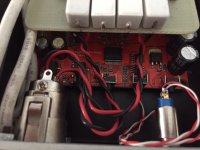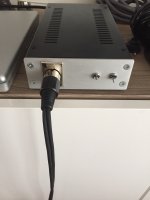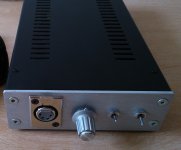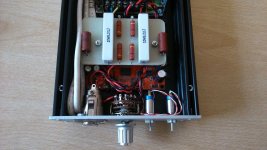And the schematics shown for DDXi-2051 look much more comprehensive than those given in the STA326 datasheet. Or maybe even more correct - compare e.g. PLL filter implementations here and there.Is it known that the STA326 is the same as this chip ? It is originally from 2004 !!
http://www.apogeebio.com/ddx/PDFs/DDXi-2051.pdf
Hi guys,
Here are some pictures of my FDA-Phone Amp using the STA-333 board !...
First tests are really amazing compared to more "classical" phone amps, even balanced ones !
Details?
Hi Burgunder,
I opened a thread on Head-fi DIY headphones forum... Here is my opening post...
After testing several FDA units (Topping, FX802, YJHiFi, etc...) most of them based on STA326 chips, I found a board based on the 333BW circuit, and the idea was to derive a high quality audio DAC-Amplifier for headphones with it...
Here is the board :
https://fr.aliexpress.com/store/pro...108.1000016.1.7f75b2ee6zYumR&isOrigTitle=true
Below are some pictures of the resulting DIY unit...
The audio quality is really amazing for the price of the prototype. Perfect silence without modulation then no noise (the so-called "black background"), very high fidelity of the instruments and voices (I have a "personal" reference...), crystal clear sound and very good dynamics ! In addition, this is a fully balanced unit.
The very important points here are that there isn't neither any DAC nor any Operational Amplifier in this device !... Thus, the path is very short between the digital signal and its audition through the headphones. These are the most important reasons of the very good audio quality obtained with this little board. The PCM is converted in PWM...
My Best
I opened a thread on Head-fi DIY headphones forum... Here is my opening post...
After testing several FDA units (Topping, FX802, YJHiFi, etc...) most of them based on STA326 chips, I found a board based on the 333BW circuit, and the idea was to derive a high quality audio DAC-Amplifier for headphones with it...
Here is the board :
https://fr.aliexpress.com/store/pro...108.1000016.1.7f75b2ee6zYumR&isOrigTitle=true
Below are some pictures of the resulting DIY unit...
The audio quality is really amazing for the price of the prototype. Perfect silence without modulation then no noise (the so-called "black background"), very high fidelity of the instruments and voices (I have a "personal" reference...), crystal clear sound and very good dynamics ! In addition, this is a fully balanced unit.
The very important points here are that there isn't neither any DAC nor any Operational Amplifier in this device !... Thus, the path is very short between the digital signal and its audition through the headphones. These are the most important reasons of the very good audio quality obtained with this little board. The PCM is converted in PWM...
My Best
Last edited:
mods picts
We made a few mods in order to have 3 different levels of attenuation to address almost all Headphones whatever their sensibility.
Here a the picts of the mods...
We made a few mods in order to have 3 different levels of attenuation to address almost all Headphones whatever their sensibility.
Here a the picts of the mods...
Attachments
Last edited:
Yes sorry... Here you have one on Ali-express :
Aiyima STA333BW USB Pure Digital Power Amplifier Board With USB Sound Card /DAC Bass & Treble Adjustment Function 20w+20w dans Amplificateur de Consumer Electronics sur AliExpress.com | Alibaba Group
But there are several others with different prices on ebay for example.
Aiyima STA333BW USB Pure Digital Power Amplifier Board With USB Sound Card /DAC Bass & Treble Adjustment Function 20w+20w dans Amplificateur de Consumer Electronics sur AliExpress.com | Alibaba Group
But there are several others with different prices on ebay for example.
Looks interesting. Wonder if would be worth to change 41/48kHz USB with good s/pdif to i2s and use as a DAC. Undersand that 2 resistors used as dummy amp loads? What are the others for?
Hi y'all,
So I finally bought a YJ HiFi STA326 amp and wow, I'm impressed.
I found a few issues - one is "dangerous" - there is a cap rated at 25V that will receive the input voltage, which if you followed the maker's guidelines could be 32V less a schottky diode. So use 24V until you get that cap out 🙂
I've done a few changes to the amp - on my blog if you're interested.
Pure Digital Amplifier and APTX-HD | myL8test
I doubt I'll ever build another DAC again.
Cheers
So I finally bought a YJ HiFi STA326 amp and wow, I'm impressed.
I found a few issues - one is "dangerous" - there is a cap rated at 25V that will receive the input voltage, which if you followed the maker's guidelines could be 32V less a schottky diode. So use 24V until you get that cap out 🙂
An externally hosted image should be here but it was not working when we last tested it.
I've done a few changes to the amp - on my blog if you're interested.
Pure Digital Amplifier and APTX-HD | myL8test
I doubt I'll ever build another DAC again.
Cheers
Nanoloop, i have a similar situation needing the supply voltage near the caps rated voltage... . so i really trying to get your opinion as my confirmation for longevity of amplifier 😀
It goes like this:
Gotten china-made amp, while its Class D chip datasheet recommends 32V (max operating at 38V), china-factory bundled with a 24V SMPS. However at this voltage, Class D amp not running at optimal power/min distortion.
I though of using 32~36V SMPS, checking its China-made amp PCB found a 25V cap which seems on side after LM2596 DC 12V regulator (ie. 24V/36 is not a concern). However rest of caps mostly rated at 35V, a couple 50V caps; so the question is:
How close the supply voltage can these caps handle safely on the long run without blowing-up or risk bring any danger (assuming on-board semiconductors could handle)?
Appreciate any thoughts...
It goes like this:
Gotten china-made amp, while its Class D chip datasheet recommends 32V (max operating at 38V), china-factory bundled with a 24V SMPS. However at this voltage, Class D amp not running at optimal power/min distortion.
I though of using 32~36V SMPS, checking its China-made amp PCB found a 25V cap which seems on side after LM2596 DC 12V regulator (ie. 24V/36 is not a concern). However rest of caps mostly rated at 35V, a couple 50V caps; so the question is:
How close the supply voltage can these caps handle safely on the long run without blowing-up or risk bring any danger (assuming on-board semiconductors could handle)?
Appreciate any thoughts...
Hi,
Do you need to max the output? These amps sound best at a couple of watts not full power. There are benefits to having a higher current available because this usually infers a lower output impedance which translates into better dynamics, but it doesn't mean you need higher voltages to get the best sound.
Caps can withstand higher than rated voltages for very brief periods before they will suddenly hiss and spit out fluid...and are dead. To achieve the stated hours of life, I've seen datasheets recommend keeping them at least 10% and preferably 20% under their rated voltage - so a 35V cap at 28V to 32V. YMMV. I've never actually had to replace an "old" cap before so I don't have experience.
Do you need to max the output? These amps sound best at a couple of watts not full power. There are benefits to having a higher current available because this usually infers a lower output impedance which translates into better dynamics, but it doesn't mean you need higher voltages to get the best sound.
Caps can withstand higher than rated voltages for very brief periods before they will suddenly hiss and spit out fluid...and are dead. To achieve the stated hours of life, I've seen datasheets recommend keeping them at least 10% and preferably 20% under their rated voltage - so a 35V cap at 28V to 32V. YMMV. I've never actually had to replace an "old" cap before so I don't have experience.
Nanoloop,
Got a question regarding YJ HiFi STA326 amp:
Is STA326 a closed loop amp, in your opinion
How does YJ compare to D802C from FXaudio (other STA326 amp) ?
Thks.
Got a question regarding YJ HiFi STA326 amp:
Is STA326 a closed loop amp, in your opinion
How does YJ compare to D802C from FXaudio (other STA326 amp) ?
Thks.
Perhaps the best in this category is Alientek D8.😉
what is in Alientek D8 compare to other FDA which your recommendation? hope to learn more, as am an amateur on these FDA amps.
Last edited:
Perhaps the best in this category is Alientek D8.😉
how is the support from china about the USB driver for PC installation?
what do you prefer? XMOS or PCM 2704 version? sound chekc compared?
Also read that Alientek D8 uses XMOS whereas YJ00361,SMSL Q5 Pro, V100,V200, D802/D802C uses PCM.
However i have difficulty understand the difference & strength betw using these 2.
wld really appreciate some education, as to what usage scenario make either more suitable.
However i have difficulty understand the difference & strength betw using these 2.
wld really appreciate some education, as to what usage scenario make either more suitable.
Is STA326 a closed loop amp, in your opinion
Since its not a matter of opinion, I'll answer this one. Its an open loop amp.
what is in Alientek D8 compare to other FDA which your recommendation? hope to learn more, as am an amateur on these FDA amps.
Comparing the D802 and D8 both have high quality SPDIF digital inputs and in this mode sound essentially identical to me. Both are good choices if your primary source is SPDIF.
The D802 has an poorer USB implementation and performs, to my ears, significantly worse with USB input that SPDIF. The D8 however has (for one of these cheap amps) an exceptionally good XMOS USB input and with this performs equally as well as with SPDIF so if you want to use USB this is the clear winner. The D8 is also available with an alternative cheaper but still decent quality USB implementation rather than the XMOS, I haven't listened to this but would expect it to be rather better than the D802.
The D8 is also physically much smaller and indeed rather cute. It's display and user interface is different so have a look at the model details and see which you prefer for that.
- Status
- Not open for further replies.
- Home
- Amplifiers
- Class D
- Full digital amplifier with chip STA326




